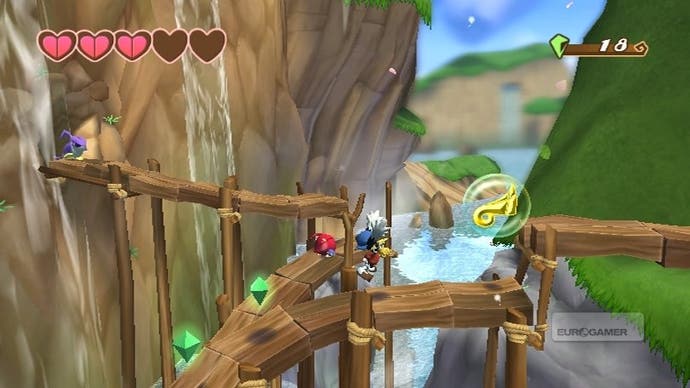Klonoa: Door to Phantomile
Do you remember the time?
Exploring Klonoa's environments is generally a pleasure. There's no doubt that each world is based on a platform game cliché. From the rolling green hills and mills of The Wind Village, to the flutter of candlelight and bat's wings in Gunston Mine, to the white foam and blue watery backdrop of Jugpot, there's nowhere here we've not visited before. But each level is beautifully designed and presented, the camera tilting and snaking to take in the best angles as you hop from ledge to ledge. It's one of the best-looking games on the console.
Compatible with just about every Wii controller and configuration you care to mention (including, Megaton-alert, the WaveBird), the game's a joy to handle whichever mode you opt for. Character control is as tight and precise as it needs to be in any platform game. However, running, jumping and using the Wind Bullet represents the full extent of Klonoa's abilities.
Later in the game he doesn't find Raccoon suits that let him fly, nor can he snack on a mushroom for a growth spurt. As such, all of the game's puzzles and challenges have to be solved by this small palette of player tools. Some enemies carry shields around, meaning they have to be attacked from behind, while others are simply too big to grab, so you have to use other means to get past them. But Namco finds it hard to build substantially on the ideas and template laid out in the first stage, resorting to dumb find-the-key puzzles to inject challenge and, as such, this is a game that impresses most in the short term.

In one sense, that's no disaster. After all, there's very little long-term to be had here. The game consists of six worlds, each of which boasts just two stages, all of which a persistent player will be able to finish in a day or two. Every stage contains six captured villagers to find but, as you gain no new abilities later in the game, every single one of these can be found on your first visit to each level if you're thorough. Once complete, you can play through the entire game in a mirror mode, but there's no Symphony of the Night-style masterplan in play here: it's a simple flip of perspective, a novelty that, once worn off, leaves little to compel you back through the game.
The result is a mixed success. In terms of its childlike spectacle, Klonoa is quite brilliant, offering a number of memorable set-pieces and an unforgettable, wistful ambience throughout. But its challenges, while obvious, are often fiddly to overcome, and the sense of deep achievement that comes from completing one of Super Mario's tasks is here replaced by mere relief that it's over. That flaw - combined with the game's brevity and limited pool of ideas - lessens our recommendation, but it doesn't quite mute it.
